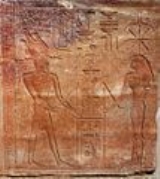
Seshat's emblem
Encyclopedia
The ancient Egypt
ian Seshat emblem hieroglyph is one of the oldest hieroglyphs from Ancient Egypt. An archaic form of it was used on the Narmer Palette
of Pharaoh Narmer
. It represents the goddess Seshat
in later classical Ancient Egypt, as the goddess is identified with it, surmounted on her head.

In classical Ancient Egypt, the Seshat Emblem was a long stem with a 7-petal flower on top and surmounted by a pair of horns; the archaic form had six petals, (as a vertical, with two crossed lines, as a 'star'), and surmounted by two enclosing sickle-shaped signs, two falcon-feathers on top.
The Seshat emblem in Egyptian
is the name of Seshat, (sš3t), and is "seshat", or "sesheta". As the origin of her name is related to the male scribe
, and she represents the female version
, it is thought her origins also involve the stars, and ancient Egyptian astronomy. Of note: the word "sesheta" means, hidden things, mysteries, secrets, so the implication is that the Pharaoh is being given access to the power of those mysteries through Goddess Seshat.
use of the Seshat's emblem is from Pharaoh, and Queen Hatshepsut
's Red Chapel.
Ancient Egypt
Ancient Egypt was an ancient civilization of Northeastern Africa, concentrated along the lower reaches of the Nile River in what is now the modern country of Egypt. Egyptian civilization coalesced around 3150 BC with the political unification of Upper and Lower Egypt under the first pharaoh...
ian Seshat emblem hieroglyph is one of the oldest hieroglyphs from Ancient Egypt. An archaic form of it was used on the Narmer Palette
Narmer Palette
The Narmer Palette, also known as the Great ierakonpolis Palette or the Palette of Narmer, is a significant Egyptian archeological find, dating from about the 31st century BC, containing some of the earliest hieroglyphic inscriptions ever found. It is thought by some to depict the unification of...
of Pharaoh Narmer
Narmer
Narmer was an ancient Egyptian pharaoh of the Early Dynastic Period . He is thought to be the successor to the Protodynastic pharaohs Scorpion and/or Ka, and he is considered by some to be the unifier of Egypt and founder of the First Dynasty, and therefore the first pharaoh of unified Egypt.The...
. It represents the goddess Seshat
Seshat
In Egyptian mythology, Seshat was the Ancient Egyptian goddess of wisdom, knowledge, and writing. She was seen as a scribe and record keeper, and her name means she who scrivens , and is credited with inventing writing...
in later classical Ancient Egypt, as the goddess is identified with it, surmounted on her head.
Seshat emblem

In classical Ancient Egypt, the Seshat Emblem was a long stem with a 7-petal flower on top and surmounted by a pair of horns; the archaic form had six petals, (as a vertical, with two crossed lines, as a 'star'), and surmounted by two enclosing sickle-shaped signs, two falcon-feathers on top.
The Seshat emblem in Egyptian
Egyptian language
Egyptian is the oldest known indigenous language of Egypt and a branch of the Afroasiatic language family. Written records of the Egyptian language have been dated from about 3400 BC, making it one of the oldest recorded languages known. Egyptian was spoken until the late 17th century AD in the...
is the name of Seshat, (sš3t), and is "seshat", or "sesheta". As the origin of her name is related to the male scribe
Scribe
A scribe is a person who writes books or documents by hand as a profession and helps the city keep track of its records. The profession, previously found in all literate cultures in some form, lost most of its importance and status with the advent of printing...
, and she represents the female version
Bread bun (hieroglyph)
The Ancient Egyptian Bread bun hieroglyph is Gardiner sign listed no. X1 for the side view of a bread bun. It is also the simple shape of a semicircle....
, it is thought her origins also involve the stars, and ancient Egyptian astronomy. Of note: the word "sesheta" means, hidden things, mysteries, secrets, so the implication is that the Pharaoh is being given access to the power of those mysteries through Goddess Seshat.
Iconographic example, Goddess Seshat
One famous example of the iconographicIconography
Iconography is the branch of art history which studies the identification, description, and the interpretation of the content of images. The word iconography literally means "image writing", and comes from the Greek "image" and "to write". A secondary meaning is the painting of icons in the...
use of the Seshat's emblem is from Pharaoh, and Queen Hatshepsut
Hatshepsut
Hatshepsut also Hatchepsut; meaning Foremost of Noble Ladies;1508–1458 BC) was the fifth pharaoh of the eighteenth dynasty of Ancient Egypt...
's Red Chapel.

